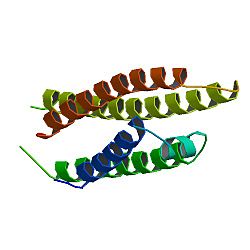Apolipoprotein E
| edit |
| Apolipoprotein E | |||||
|---|---|---|---|---|---|
 PDB rendering based on 1b68. | |||||
| |||||
| Identifiers | |||||
| Symbols | APOE; AD2; MGC1571; apoprotein | ||||
| External IDs | OMIM: 107741 MGI: 88057 HomoloGene: 30951 GeneCards: APOE Gene | ||||
| |||||
| RNA expression pattern | |||||
 | |||||
 | |||||
 | |||||
| More reference expression data | |||||
| Orthologs | |||||
| Species | Human | Mouse | |||
| Entrez | 348 | 11816 | |||
| Ensembl | ENSG00000130203 | ENSMUSG00000002985 | |||
| UniProt | P02649 | Q3TX45 | |||
| RefSeq (mRNA) | NM_000041 | NM_009696 | |||
| RefSeq (protein) | NP_000032 | NP_033826 | |||
| Location (UCSC) | Chr 19: 50.1 - 50.1 Mb | Chr 7: 18.85 - 18.86 Mb | |||
| PubMed search | [1] | [2] | |||
Apolipoprotein E (APOE) is a class of apolipoprotein found in the chylomicron and IDLs that binds to a specific receptor on liver cells and peripheral cells. It is essential for the normal catabolism of triglyceride-rich lipoprotein constituents.[1]
Contents[hide] |
[edit] Function
APOE[2] is essential for the normal catabolism of triglyceride-rich lipoprotein constituents. APOE was initially recognized for its importance in lipoprotein metabolism and cardiovascular disease. More recently, it has been studied for its role in several biological processes not directly related to lipoprotein transport, including Alzheimer's disease (AD), immunoregulation, and cognition.
In the field of immune regulation, a growing amount of studies point to APOE's interaction with many immunological processes, including suppressing T cell proliferation, macrophage functioning regulation, lipid antigen presentation facilitation (by CD1) to natural killer T cell as well as modulation of inflammation and oxidation.[3]
Neonates with brain injuries and/or defects who also have abnormalities in the APOE gene may have an increased risk for cerebral palsy, according to researchers at the Northwestern University Feinberg School of Medicine[citation needed]. Defects in APOE result in familial dysbetalipoproteinemia, or type III hyperlipoproteinemia (HLP III), in which increased plasma cholesterol and triglycerides are the consequence of impaired clearance of chylomicron, VLDL and LDL remnants[citation needed].
APOE is 299 amino acids long and transports lipoproteins, fat-soluble vitamins, and cholesterol into the lymph system and then into the blood. It is synthesized principally in the liver, but has also been found in other tissues such as the brain, kidneys, and spleen. In the nervous system, non-neuronal cell types, most notably astroglia and microglia, are the primary producers of APOE, while neurons preferentially express the receptors for APOE. There are seven currently identified mammalian receptors for APOE which belong to the evolutionarily conserved low density lipoprotein receptor gene family.